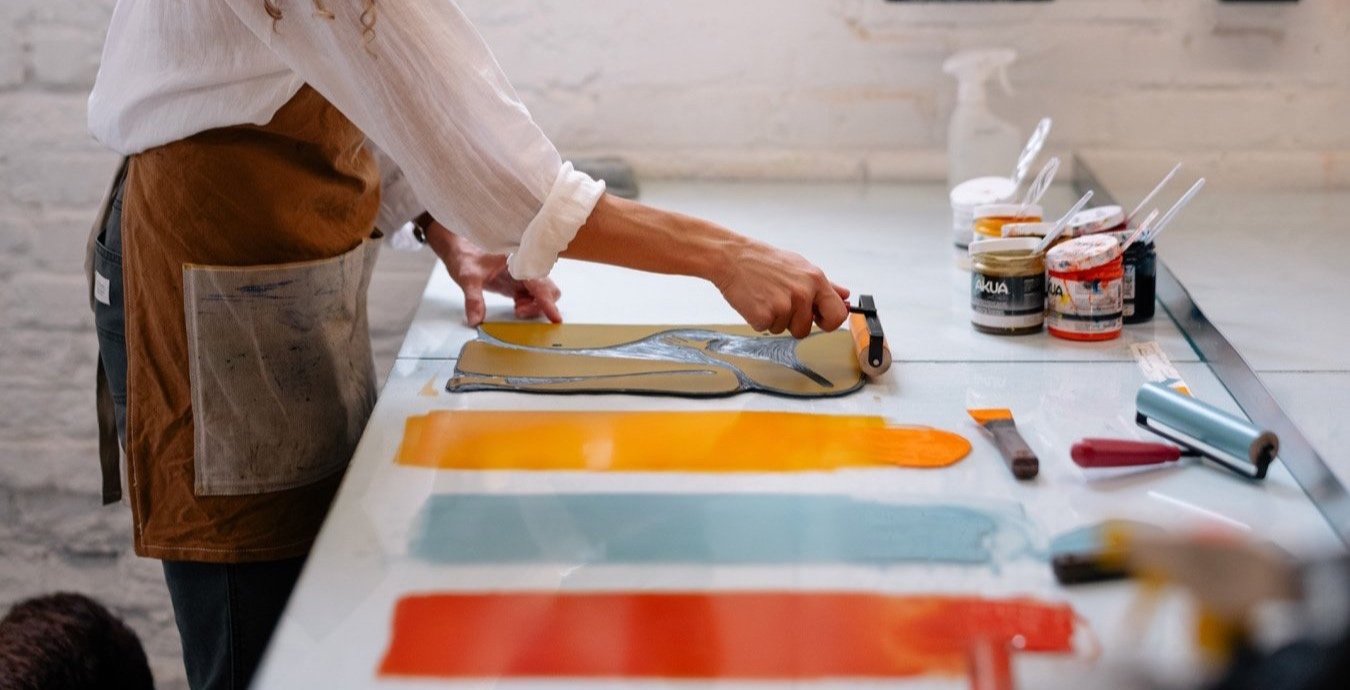
Print Medium + Process
What is relief printing?
Relief printmaking is an ancient art form that originated during the Han Dynasty in China. The earliest known example is a woodblock print dating between 206 B.C. and 220 A.D. By the 1920s and 30s, linoleum gained popularity as a printmaking material due to its ease of use, replacing wood while still utilizing the same relief techniques. While Pablo Picasso is better known for his paintings, he is credited with popularizing linocut techniques in the 1950s.
THE PRINT PROCESS
•
THE PRINT PROCESS •
Relief Printing
SKETCHING THE IMAGE
1. Each print begins at the drawing board—each layer sketched on tracing paper to play around and see how the layers will interact. The final sketch is then transfered to a block of linoleum.
CARVING THE BLOCK
2. Using specialized linocut tools, I meticulously carve away the sections of the linoleum that I want to remain unprinted (the white areas of the print). This requires precision and patience, as I work to create texture and depth in the image. The remaining/raised surface of the linoleum holds the ink, which will be transfer to the paper.
INKING THE BLOCK
3. After the block is carved, I roll ink onto the surface using a brayer roller. The ink is evenly distributed on the raised parts of the linoleum—those that were not carved away. I mix custom colors tailored to the specific effect I want to achieve.
PRINTING THE IMAGE
4. The inked linoleum block is placed on the bed of the press within the registration matrix. The paper is carefully laid over the block. Additional papers are layered over for extra cushion. I turn the wheel of the press to move the block and paper under the drum. This applies even pressure to ensure my design is properly transferred. Each color is layered individually, one block at a time (repeating step 3 and 4).
PRINT REVEAL
5. After going through the printing press, I hand-pull the print to reveal the transferred image.
DRYING + EDITIONING
6. The print is carefully laid on a drying rack. Each print is unique due to slight variations in ink application and pressure due to their handmade, hand-printed nature. Once dried, I inspect each print carefully to make sure that it meets my standards to be included in the limited edition. Then I sign, date, title, and edition each print. You can learn more about how editioning works here.
What is screen printing?
Contemporary screen printing was popularized by Andy Warhol and the Pop Art movement of the 1950s and 60s.
This time-honored technique has roots that go back to many ancient cultures, although the process as we know it today began to take shape in the late 1800s, where it was used for patterned textile printing.
A "silkscreen" is a frame with silk stretched over it, though today, a synthetic mesh is used.
Each color within the artwork is separated onto an individual screen. Once the screens are prepared, ink is pushed through each screen by pulling a squeegee across it, transferring the ink onto the paper.
This is done by hand, one color at a time, ensuring that each new layer aligns properly with the other printed colors. The hand-made nature of this process gives slight nuances to each print, adding a unique quality, despite it being part of an edition.










